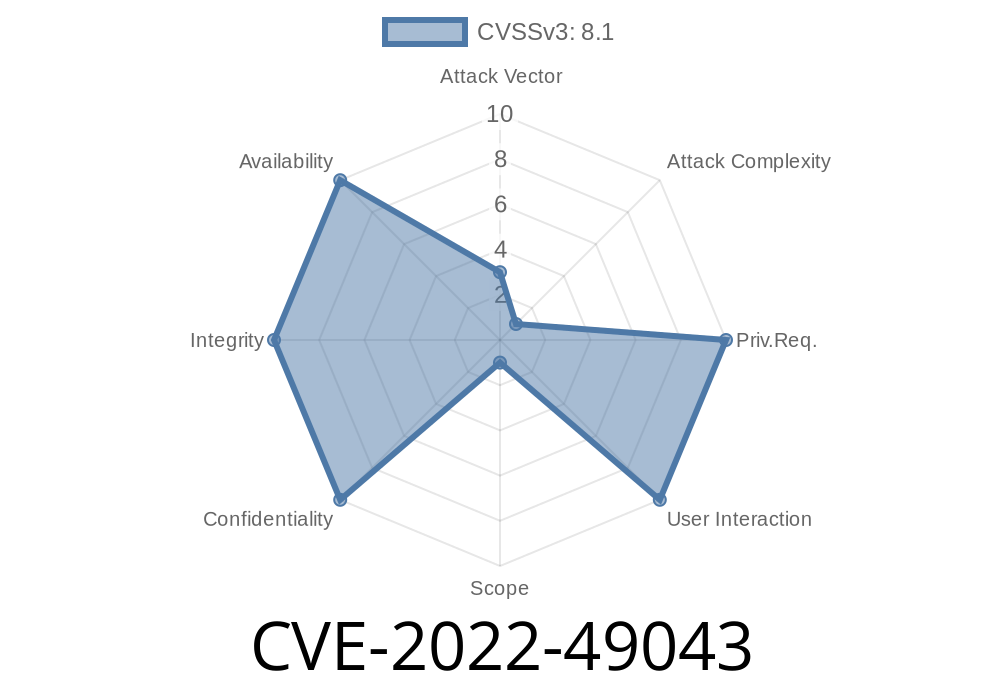CVE-2022-49043 refers to a critical vulnerability discovered in the popular open-source library, libxml2, which is responsible for parsing and manipulating XML files. This library is widely used across various platforms and applications, making it a popular target for attackers.
In this long read, we will explore the details of this vulnerability, specifically involving the xmlXIncludeAddNode function used in the xinclude.c file of libxml2, before version 2.11.. We will dive into code snippets, original references, and exploit details to better understand the implications of this use-after-free vulnerability.
Background
The xmlXIncludeAddNode function is responsible for handling the XInclude process which allows XML files to be built using smaller XML components referenced in another file. This function is vulnerable to a use-after-free situation, where a pointer is accessed after the memory has been freed, leading to potential data leakage, application crashes, or even remotely exploitable code execution.
Code Snippet
The following is a snippet of code from the xmlXIncludeAddNode function in the xinclude.c file of libxml2:
static xmlChar *
xmlXIncludeAddNode(xmlXIncludeCtxtPtr ctxt, xmlNodePtr cur) {
...
for (i = ;i < ctxt->incMax;i++) {
xmlNodePtr test = ctxt->incNodes[i];
if (test == NULL) {
ctxt->incNodes[i] = cur;
return;
}
}
...
}
The vulnerability lies in the fact that the xmlNodePtr cur is added to the ctxt->incNodes list without verifying if the node has been previously freed.
Original References
1. The commit in the libxml2 Git repository: https://gitlab.gnome.org/GNOME/libxml2/-/commit/5c44733a64c2eb9e8481a2a730fa1ea664f770
2. The libxml2 advisory: https://gitlab.gnome.org/GNOME/libxml2/-/issues/243
Exploit Details
An attacker with control over the parsing of an XML file could craft an XML file that abuses this use-after-free vulnerability. This can be achieved by creating an XInclude directive in the XML to refer to a freed node. When the parser includes the freed node, the xmlXIncludeAddNode function would access the freed memory location, leading to potentially dangerous consequences.
Craft an XML file with an XInclude directive, including elements from another XML file
2. Use a specific sequence of XInclude operations, including having a recursive file inclusion that leads to memory exhaustion and failure in allocation, causing the freeing of the node being included
3. Finally, execute another XInclude operation that triggers the use of the freed node, causing a use-after-free vulnerability
Mitigation
The libxml2 developers have fixed this vulnerability in version 2.11. by introducing additional checks to prevent the use of a freed node. Upgrading to this version or a newer version of libxml2 will protect against this vulnerability.
Conclusion
CVE-2022-49043 highlights the importance of staying up-to-date with the latest security patches for widely used software libraries. By updating libxml2 to version 2.11. or later, this use-after-free vulnerability in the xmlXIncludeAddNode function can be effectively mitigated. It is crucial for both developers and system administrators to be proactive in securing their software from the latest security threats, ensuring the integrity and security of their applications and environments.
Timeline
Published on: 01/26/2025 06:15:21 UTC
